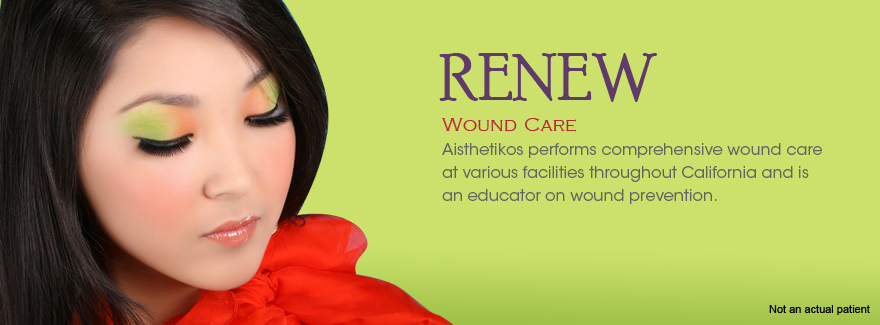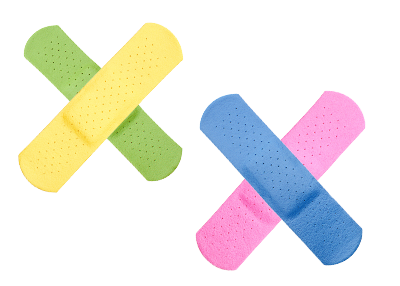Renew
COMMON PROCEDURES:

- Local Tissue Flaps or Skin Grafting
(reconstruction after tumor excision or complex wound coverage) - Wound Debridement
- Complex Wound Treatments & Dressing Application
(negative pressure, layered compression, and others)
Comprehensive Wound Care
WOUND DEBRIDEMENT
BASIC WOUND CARE
The first evidence of wound care can be traced back to ancient Egypt in 2400BC. We have come a long way since then, but the basic principles of treatment remain the same.
Wound debridement is one of the mainstays of wound care and often necessary not only to speed up wound closure, but in some cases to simply achieve healing.
WHAT IS DEBRIDEMENT?
Debridement is the act of removing dead tissue, contaminated tissue, adherent tissue, or foreign material. This is essentially the removal of all materials that promote infection and delay healing.
Debridement can be performed in the following three ways:
-
Enzymes
- Topically applied medications that breakdown the nonviable cells and leave behind the healthy cells.
-
Non selective treatments
- Routine treatments such as dressing changes or hydrotherapy, that remove some (usually minimal amounts) of the unhealthy tissue.
-
Selective procedures
- Minor procedures performed by a trained professional to physically remove the dead and diseased tissue down to healthy, viable tissue.
Of the debridement options, selective (often called surgical) procedures are the most effective method of removing necrotic tissue, but require clinical skill and judgment. Enzymatic debridement works well over time, but unfortunately the best agents were taken off the market by the FDA in January 2009, until further research can be done on safety and efficacy of these products. Non selective debridement options work well if the wound bed is clean, but are often not aggressive enough to clean up wounds with devitalized tissue.
WHY DO WOUNDS NEED DEBRIDEMENT?
Removal of unhealthy tissue is a prerequisite to new tissue growth. Devitalized tissues are a source of endotoxins that inhibit proper wound healing and increase the chance of infection.
Many long-standing (chronic) wounds have lost the stimulation by the body to heal, in part due to reduced amounts of wound healing factors. In chronic wounds the act of debridement can "trick" the body into thinking that the wound is new (or acute). This in turn causes the body to send the proper growth factors to the wound, which begin the cascade of events necessary for normal wound healing.
HOW IS BEDSIDE WOUND DEBRIDEMENT PERFORMED?
The wound is first anesthetized with a topical numbing agent. Patients with extremely painful wounds may be given pain medications by the nurse prior to the procedure.
A curette (a spoon-shaped surgical instrument) is used to scrape the wound surface clean, removing any necrotic tissue or wound debris. Once debridement is complete the wound is dressed as usual and daily treatment is resumed.
If at any time the procedure becomes too uncomfortable, the debridement is stopped. Pain control is the primary goal. Our aim is to obtain the maximum amount of healing with the least amount of discomfort to the patient.

HOW OFTEN IS THE WOUND DEBRIDED?
This varies depending on the individual patient and the particular wound. Some wounds never need debridement, some may need it only once, and some may need cleaning on a weekly basis. The wound is reevaluated at serial intervals to determine if debridement would aid in successful wound closure.
WHAT ARE THE BENEFITS?
Increased rate of wound healing and reduction in the rate of infection are the most significant benefits obtained by wound debridement.
WHAT ARE THE RISKS?
Bedside wound debridement is generally well tolerated and the risks are usually minimal. The most common risks include (but are not limited to) pain and bleeding, both of which, if present, tend to be minor.
EXAMPLES
Slough (Yellow wound debris) cleared:

Eschar (dark, leathery devitalized tissue) removed:

Slough, necrotic tissue (dark area) and callous debrided:

Slough cleaned:

Wound Care Division
Why Utilize Aisthetikos, Inc. Plastic Surgery for Wound Care?
- Services are provided at no cost to you
- Plastic Surgeons are the most specialized & highly trained wound care providers.
- Wound evaluation & treatment plan documentation by physician
- Accelerated wound healing time
- Prevention of Facility acquired wounds
- Prevention of secondary complications associated with pressure ulcers and wounds
- Increased treatment nurse confidence due to physician backing
- Patient/Staff Education
- Assistance with Quality Assurance Projects to reduce the incidence and prevalence of wounds
- On-call consultants with up-to-date knowledge on current treatment methods and reimbursement requirements
- Decrease in the overall economic impact associated with pressure ulcers and wounds
- Unique facility service
Aisthetikos, Inc. Plastic Surgery provides comprehensive wound care evaluation, treatment and consulting at no charge to the facilities. Our skilled wound care team provides full spectrum wound care including: stress prevention, treatment with pain management, debridement, operative repair including: direct closure, skin grafting, skin flaps, flaps and free flaps. Our team will monitor outcomes and identify deficiencies. Our team will also provide staff, family and patient education including: discussing etiology, pathology, risk factors, terminology, principles of wound healing, nutritional support, cleaning, infection control, positioning, prevention, product selection, and documentation.
Addressing management of pressure ulcers in now a prominent national healthcare issue. Pressure ulcers have affected nursing home populations for years and despite current interest and advances in medicine, surgery, nursing care, and self-care education, pressure ulcers remain a major cause of morbidity and mortality. This is particularly true for the skilled nursing patient population which includes persons with impaired sensation, prolonged immobility, or advanced age.
Key Findings in data from the National Nursing home survey published in February 2009 showed that 11% of nursing home residents had pressure ulcers, and stage 2 ulcers were the most common. That is more that 1 in 10 residents that had pressure ulcers. In the nursing home environment, the prevalence of pressure ulcers is in the range of 2.6-24%. The incidence is 25% in residents admitted from an acute care hospital. Patients with preexisting pressure ulcers demonstrate a 26% incidence of additional pressure ulcer formation over a 6-month long period. Follow-up over a long period of time demonstrates that most ulcers healed with treatment within a year.
Patients predisposed to pressure ulcers are at higher risk of morbidity and mortality. Infection is the most common major complication of pressure ulcers. Approximately 60,000 people die each year from complications of pressure ulcers.








